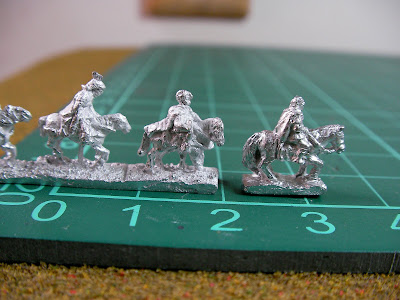
Taking stock the other day, I realised just how long it had been since I had put brush to a 2mm sized mini, and had to go and have a quick lie down - how dare I neglect the one true scale for such a long time?
What with splashing about with 1/3000th boats, and between 1/300th Doctors, monsters, machinery, and Legionaries, 1/900th had been unjustly taking rather a back seat.
Once the swooning shock had passed, I resolved to do some research into a possible new project. (Yes, yes, I have plenty of unfinished ones, but that is hardly the point is it? - there is nothing like the anticipation of adding more to the Lead Mountain now is there....)
I did censor my thoughts in as much as I think it would be best if any new direction would have some cross-over potential, and was reminded that my fledgling Land Ironclads and Weird WWI Land Dreadnought forces lacked anything in the way of credible ground troops.
It seemed sensible then, to take the approach of exploring what this period might have to offer, but hopefully with somewhat of a twist to make it more interesting and therefore easier in terms of inspiration.
I had been admiring the completed 2mm bases recently on display over at Fjodin's Victorian House, particularly his colourful Ottoman infantry, and furthermore had been perusing the now freely available online Nafziger Orders of Battle for the late nineteenth and early twentieth century, so looking at a rough timescale between say 1880 and 1920, it came down to portraying a Colonial force, that could either campaign historically, or in a more fantastic setting.
The Nafziger documents are here; just use the search button to pick your period/conflict:
The only quandary I faced was the fact that a Colonial force, although able to fight the world over, would inevitably mean a sea of Khaki, or, if made up of Victoria's boys in red, would necessarily be visually restricted to an earlier era.
This is when I hit upon the idea of having a look at the Wolseley Campaign in Egypt in 1882, just on the verge of the Mahdist era, which, with a few exceptions, saw the last widespread use of the red tunic in battle by the British, alongside other units which wore the Khaki.
If I was to base my force around the order of battle from this campaign, then I would be able to depict a whole range of colourful units, as well as have troops that might fit into an earlier time frame, say the Zulu War, or forward into the North West Frontier of the 1920s.
Furthermore, if I added the lovely white uniformed and red fezzed Egyptians into the mix, then I could have the opportunity to engage in conventional warfare as well as something with a more VSF flavour.
There is a truncated, but nevertheless illustrative extract of the Osprey on the campaign available online at Google Books, along with a number of other previews for a quick reference:
The campaign, if used as a framework, enables red coated troops of the Guards alongside khaki-wearers from the Indian contingent regiments; there is a whole Highland Brigade as well as the blue jacketed sailors of the Naval Brigade, there are Household Cavalry alongside Bengal Lancers, green jacketed Rifleman and even an armoured 'siege train' mounting Naval ordnance!
Throw into the mix the white of the Egyptian regulars, some tribal auxiliaries for colour, and I should be covering enough bases to enable infantry to be used in any number of wars.
In the back of my mind, of course, there is still the possibility of going full hog and having a look at the Zulus or Mahdists themselves, but that is definitely for another day!
So lots of planning to do then, and hopefully some test bases in the coming ten days or so, but most importantly a whole new area to explore using 2mm.
The requisite Nafziger document, so kindly donated for free research by the man himself, is available in a direct link to the PDF here:
(The postcard view at the top of the post is one from my collection, and was produced by George Falkner & Sons, Manchester. I just wish I had more of the set, which must have depicted the whole line at Omdurman - with handy notes on which unit stood where, for future wargamers!)


















































